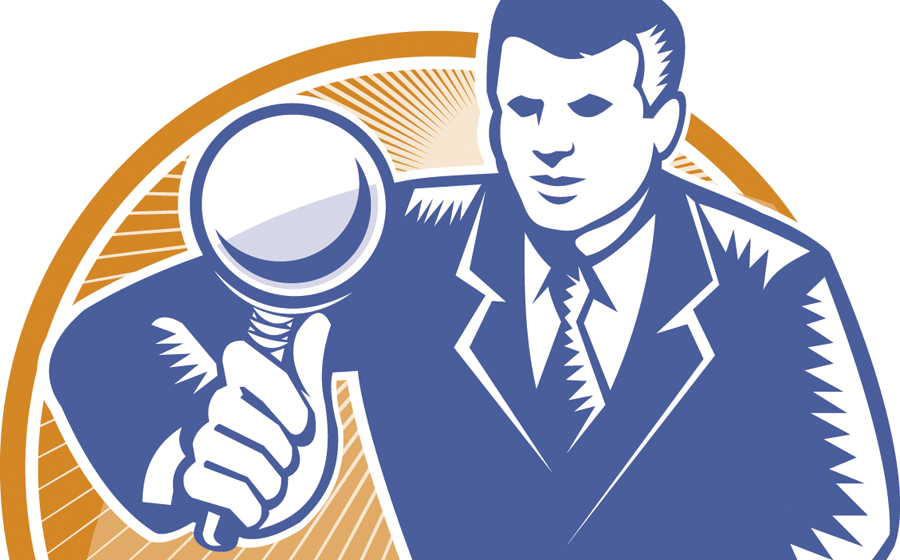Protect your bottom line by auditing trade show invoices at your next show.
What you find may surprise you. By Candy Adams

f I had to guess, I'd say about 50 percent of the show invoices I receive have at least one error on them – and the more complex the invoice, the more errors I find. Although some errors are unavoidable, your best defense is to keep an extensive paper trail. Hold on to fax confirmations and emails with scanned copies of show orders, copies of online order confirmations, pre-show change requests, on-site labor tickets, certified weight slips, and any other hard-copy backup to the agreement and deposits made. If you can't get these documents from a vendor to match the invoice, opening (or threatening to open) a dispute with your credit-card company has a miraculous effect of bringing missing documentation issues to a quick and usually favorable resolution.
Don't get me wrong. Not all errors I find on invoices are in the financial favor of the vendor, but the majority of them seem to be. Is this due to careless bookkeeping or a desire to squeeze a little more profit out of exhibitors who just don't have – or take – the time to audit? I can't say for sure.
Regardless of who benefits from the errors, I believe in being fair. If I find an error that's not in my favor, I tell the vendor so it can correct the invoice. What better way to cement a long-term partnership than by being honest and ethical?
I wish I could tell you that there are a set number of errors to watch for, but it seems like every show brings a new batch of boo-boos. That said, here are some of the budget busters I watch for when auditing invoices, broken down by service provider. If these charges pop up on your invoices, notify the biller and request a correction.
 Exhibit Houses
Exhibit Houses

Missed credits for discounts negotiated on the exhibitor's behalf. This includes shipping discounts, installation-and-dismantle labor-rate discounts, supervisory I&D fee waivers, and early bird pricing on show services.

Undisclosed fees, such as a 3- to 5-percent handling fee or surcharge for credit-card use. This charge is illegal in 10 states: California, Colorado, Connecticut, Florida, Kansas, Maine, Massachusetts, New York, Oklahoma, and Texas.

Failure to meet discount deadlines. When I negotiate to have an exhibit house provide "turnkey" service to order show services, I also note in the agreement that it is responsible for meeting all discount deadlines, since missing the deadline can result in doubling the total bottom-line cost of the services when including the additional turnkey fees.

Exhibit-property disposal fees. I've requested and been charged for the disposal of exhibit properties, then subsequently found the same properties still listed on my quarterly storage inventory invoice.

Exhibit-storage fees. There are many ways to compute exhibit storage. Make sure you understand how you're being charged. After paying for storage to the center of the aisle between crates to guarantee anytime access, I've been charged to move other exhibitors' crates that were blocking my access.

Fraudulent billing. Based on a bad experience with an unscrupulous vendor that was using inflated show orders (that were subsequently reduced or canceled) rather than actual paid invoices as backup for show invoices, I now request copies of invoices showing actual payments.
 Transportation
Transportation

Omitted standard charges on quotes. Always ask for an all-inclusive quote so you're not missing any of the commonly anticipated fees such as fuel surcharges, security charges, weight minimums, and amount of detention (aka wait) time included in the quote.

Ancillary fees for services that were not disclosed or negotiated in the original shipping quote. These include fees for additional labor and special equipment.
 Material Handling
Material Handling

Incorrect weight. Years ago I was charged material-handling fees for the weight of the entire tractor-trailer, not just my exhibit freight, quadrupling my drayage bill. This happened when the gross weight (tractor, trailer, and freight) was copied from the certified weight slip instead of the net weight (just the freight).

Wrong rate per hundredweight (CWT). Verify that the rate you're being charged per CWT matches your specific type of freight (crated, mixed, or blanket wrapped) and compare it to the rates quoted on the material-handling form in your exhibitor manual.

Overtime loading. I was charged the overtime material-handling rate at a show because the general services contractor misplaced one of my high-value equipment crates. I've also been billed overtime (OT) for my move-out material handling when only 10 minutes of the two-hour load out was actually completed on OT. Fortunately, when I contested both of these charges with the GSC's exhibitor-services reps after the show, the overtime penalties were removed.

Off-target material-handling charges. I've been charged a penalty for an off-target, direct-to-site move-in when I'd requested – and received – a written variance since I was coming in with a shipment from another show. I've found it helpful to provide the truck driver with a printed copy of the variance to present in the marshaling yard, along with the inbound bill of lading and certified weight slip, to avoid these communication breakdowns and subsequent fees.

Marshaling-yard fees. It costs the GSC money to rent, staff, and maintain the marshaling yard for trucks, and some of these fees may be passed on to exhibitors. Beware of being charged marshaling-yard fees for deliveries if the company delivering your freight is a small-package carrier such as FedEx or UPS. This freight is usually delivered directly to a special small-package dock at the show site.

Small-package drayage rates. Some shows offer a small-package rate for parcels under a specified weight, such as 35 or 50 pounds. Check your invoice for any small packages that qualify so you're not paying for the 200- to 300-pound material-handling minimum standard at most shows.
 Electrical
Electrical

On-site power. Verify the number of outlets and the amperage of your electrical hook-ups. I've been charged for power I didn't order based on the electricians using another exhibitor's order and layout to install my electrical hookups.

Early bird discounts. Obtain written confirmation that your electrical order was received by the discount deadline and have this confirmation with you at the show.
Electrical surcharges for items such as 24-hour power and high-voltage power. When in doubt about the electrical services to order, check with the lead electrician working the show and submit a copy of your floor plan.

Material charges. You'll be billed for the cost of renting the materials necessary to connect ordered power to your equipment and lighting (e.g., extension cords, surge protectors, adapters, gaff tape, etc.). Verify that the items for which you're billed are actually being provided.
 Carpet, Pad, and Cleaning
Carpet, Pad, and Cleaning

Labor and materials. Read your carpet order form carefully to find out exactly what's included if you are renting carpet. Some GSCs bundle carpet, pad, two types of tape, Visqueen, labor, and multiday cleaning into a cost-saving package. Others charge individually for these items.

Phantom carpet. If you rent carpet from the GSC for your 10-by-10-foot exhibit, you'll probably get a 9-by-10-foot piece. The 1-foot shortage is due to the GSC recycling 9-foot-wide aisle carpet, cut into 10-foot widths, and using that for booth carpet. But you will still be charged the 100-square-foot minimum fee for vacuuming. If you dispute this based on the GSC's inability to vacuum something that doesn't exist, some will be fair and reduce your cleaning bill by 10 percent.
 I&D Labor
I&D Labor

Hours worked. Whether you are using I&D labor from the GSC or an exhibitor-appointed contractor (EAC), always verify the total number of straight time and overtime hours billed for each crew member on the handwritten document (aka hard card) that lists the names, start and stop times, and total hours worked by your I&D crew members. If you are supervising setup, you'll be asked to sign these at the end of each shift. Then compare the labor charges on your invoice to your daily hard cards.

Double billing of lead labor. When I was a rookie exhibit coordinator, the lead on my labor crew kept disappearing from my booth. I discovered that he was supervising setup for another exhibitor, too. I spoke with that exhibitor, and we determined that the EAC was double billing – knowingly charging both of us for 100 percent of the lead's day-labor rate, airfare, car, hotel, and per diem. After the show, I questioned this billing practice all the way up to the EAC's president. He told me this is a common practice in the industry and to "get over it." I did – and permanently got over using this company for my EAC labor. Make sure the word "exclusive use" appears in your contracts if you're paying for the work and expenses of a traveling lead supervisor.

Supervisory fee. Check your invoice for this charge (25 to 35 percent of your total labor bill). It sometimes pops up even if you didn't order it.

Material charges. If you're providing your own I&D materials, such as double-sided carpet tape, shipping tape for your carpet pad, cleaning supplies, strapping, stretch wrap, etc., check your labor invoice to make sure your I&D contractor hasn't charged you for them. Some labor contractors charge an undisclosed, fixed, flat percentage of your total labor bill for materials such as cleaning and shipping supplies whether they are used or not. Ask that this charge be removed.
Diligence Pays Off
Due diligence when auditing your show bills for discrepancies can lead to a healthier bottom line for your exhibit program. And don't pass up the opportunity to share your money-saving scrutiny with your company's management team. After all, there's gold in "them thar bills" – and you're the one who found it.




 f I had to guess, I'd say about 50 percent of the show invoices I receive have at least one error on them – and the more complex the invoice, the more errors I find. Although some errors are unavoidable, your best defense is to keep an extensive paper trail. Hold on to fax confirmations and emails with scanned copies of show orders, copies of online order confirmations, pre-show change requests, on-site labor tickets, certified weight slips, and any other hard-copy backup to the agreement and deposits made. If you can't get these documents from a vendor to match the invoice, opening (or threatening to open) a dispute with your credit-card company has a miraculous effect of bringing missing documentation issues to a quick and usually favorable resolution.
f I had to guess, I'd say about 50 percent of the show invoices I receive have at least one error on them – and the more complex the invoice, the more errors I find. Although some errors are unavoidable, your best defense is to keep an extensive paper trail. Hold on to fax confirmations and emails with scanned copies of show orders, copies of online order confirmations, pre-show change requests, on-site labor tickets, certified weight slips, and any other hard-copy backup to the agreement and deposits made. If you can't get these documents from a vendor to match the invoice, opening (or threatening to open) a dispute with your credit-card company has a miraculous effect of bringing missing documentation issues to a quick and usually favorable resolution.  Material Handling
Material Handling Electrical
Electrical Carpet, Pad, and Cleaning
Carpet, Pad, and Cleaning I&D Labor
I&D Labor



